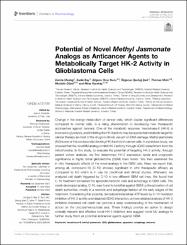| dc.contributor.author | Uludağ, Damla | |
| dc.contributor.author | Bay, Sadık | |
| dc.contributor.author | Onur Sucu, Bilgesu | |
| dc.contributor.author | Şavluğ İpek, Özgecan | |
| dc.contributor.author | Mohr, Thomas | |
| dc.contributor.author | Güzel, Mustafa | |
| dc.contributor.author | Karakaş, Nihal | |
| dc.date.accessioned | 2022-06-23T11:39:44Z | |
| dc.date.available | 2022-06-23T11:39:44Z | |
| dc.date.issued | 2022 | en_US |
| dc.identifier.citation | Uludağ, D., Bay, S., Onur Sucu, B., Şavluğ İpek, Ö., Mohr, T., Güzel, M. ... Karakaş, N. (2022). Potential of novel methyl jasmonate analogs as anticancer agents to metabolically target HK-2 activity in glioblastoma cells. Frontiers in Pharmacology, 13. http://doi.org/10.3389/fphar.2022.828400 | en_US |
| dc.identifier.issn | 1663-9812 | |
| dc.identifier.uri | http://doi.org/10.3389/fphar.2022.828400 | |
| dc.identifier.uri | https://hdl.handle.net/20.500.12511/9531 | |
| dc.description.abstract | Change in the energy metabolism of cancer cells, which display significant differences compared to normal cells, is a rising phenomenon in developing new therapeutic approaches against cancers. One of the metabolic enzymes, hexokinase-II (HK-II) is involved in glycolysis, and inhibiting the HK-II activity may be a potential metabolic target for cancer therapy as most of the drugs in clinical use act on DNA damage. Methyl jasmonate (MJ) is one of the compounds blocking HK-II activity in cancer cells. In a previous study, we showed that the novel MJ analogs inhibit HK-II activity through VDAC detachment from the mitochondria. In this study, to evaluate the potential of targeting HK-2 activity, through patient cohort analysis, we first determined HK-2 expression levels and prognostic significance in highly lethal glioblastoma (GBM) brain tumor. We then examined the in vitro therapeutic effects of the novel analogs in the GBM cells. Here, we report that, among all, compound-10 (C-10) showed significant in vitro therapeutic efficacy as compared to MJ which is in use for preclinical and clinical studies. Afterward, we analyzed cell death triggered by C-10 in two different GBM cell lines. We found that C-10 treatment increased the apoptotic/necrotic cells and autophagy in GBM cells. The newly developed analog, C-10, was found to be lethal against GBM by the activation of cell death authorities, mostly in a necrotic and autophagic fashion at the early stages of the treatment. Considering that possibly decreased intracellular ATP levels by C-10 mediated inhibition of HK-2 activity and disabled VDAC interaction, a more detailed analysis of HK-2 inhibition-mediated cell death can provide a deep understanding of the mechanism of action on the oncosis/necroptosis axis. These findings provide an option to design clinically relevant and effective novel HK-II inhibitors and suggest novel MJ analogs to further study them as potential anticancer agents against GBM. | en_US |
| dc.description.sponsorship | European Cooperation in Science and Technology (COST) | en_US |
| dc.language.iso | eng | en_US |
| dc.publisher | Frontiers Media S.A. | en_US |
| dc.rights | info:eu-repo/semantics/openAccess | en_US |
| dc.rights | Attribution 4.0 International | * |
| dc.rights.uri | https://creativecommons.org/licenses/by/4.0/ | * |
| dc.subject | Hexokinase-II | en_US |
| dc.subject | Methyl Jasmonate | en_US |
| dc.subject | 2DG | en_US |
| dc.subject | Glioblastoma | en_US |
| dc.subject | Apoptosis | en_US |
| dc.subject | Autophagy | en_US |
| dc.subject | Necrosis | en_US |
| dc.title | Potential of novel methyl jasmonate analogs as anticancer agents to metabolically target HK-2 activity in glioblastoma cells | en_US |
| dc.type | article | en_US |
| dc.relation.ispartof | Frontiers in Pharmacology | en_US |
| dc.department | İstanbul Medipol Üniversitesi, Rektörlük, Sağlık Bilim ve Teknolojileri Araştırma Enstitüsü | en_US |
| dc.department | İstanbul Medipol Üniversitesi, Rektörlük, Rejeneratif ve Restoratif Tıp Araştırmaları Merkezi (REMER) | en_US |
| dc.department | İstanbul Medipol Üniversitesi, Sağlık Hizmetleri Meslek Yüksekokulu, Tıbbi Laboratuvar Teknikleri Ana Bilim Dalı | en_US |
| dc.department | İstanbul Medipol Üniversitesi, Uluslararası Tıp Fakültesi, Dahili Tıp Bilimleri Bölümü, Tıbbi Farmakoloji Ana Bilim Dalı | en_US |
| dc.department | İstanbul Medipol Üniversitesi, Tıp Fakültesi, Temel Tıp Bilimleri Bölümü, Tıbbi Biyoloji Ana Bilim Dalı | en_US |
| dc.authorid | 0000-0001-8089-1330 | en_US |
| dc.authorid | 0000-0003-0957-6965 | en_US |
| dc.authorid | 0000-0003-1827-9540 | en_US |
| dc.authorid | 0000-0002-1423-0435 | en_US |
| dc.authorid | 0000-0002-9096-1512 | en_US |
| dc.identifier.volume | 13 | en_US |
| dc.relation.publicationcategory | Makale - Uluslararası Hakemli Dergi - Kurum Öğretim Elemanı | en_US |
| dc.identifier.doi | 10.3389/fphar.2022.828400 | en_US |
| dc.institutionauthor | Uludağ, Damla | |
| dc.institutionauthor | Bay, Sadık | |
| dc.institutionauthor | Onur Sucu, Bilgesu | |
| dc.institutionauthor | Şavluğ İpek, Özgecan | |
| dc.institutionauthor | Güzel, Mustafa | |
| dc.institutionauthor | Karakaş, Nihal | |
| dc.identifier.wosquality | Q1 | en_US |
| dc.identifier.wos | 000807209300001 | en_US |
| dc.identifier.scopus | 2-s2.0-85131799768 | en_US |
| dc.identifier.pmid | 35677429 | en_US |
| dc.identifier.scopusquality | Q1 | en_US |



















